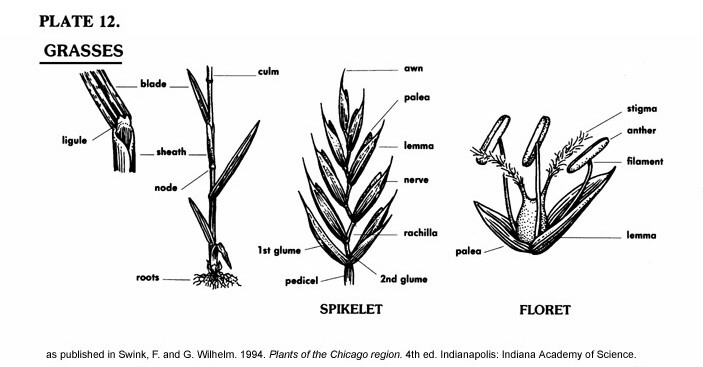
The family Poaceae is considered the most economically important plant family due to the fact that they produce the world’s food staples including domesticated cereal crops such as maize [corn], wheat, rice, barley, and millet. Poaceae plants also provide forage, building materials [bamboo, thatch, straw] and fuel [ethanol].
Agricultural grasses grown for their edible seeds are called cereals or grains [although in terms of agriculture, grains refer to both cereals and legumes]. Of all crops, 70% are grasses. Three cereals – rice, wheat, and maize (corn) – provide more than half of all calories eaten by humans. Cereals constitute the major source of carbohydrates for humans and may also be the major source of protein.
Rice is the dominant crop in southern and eastern Asia, maize in Central and South America, and wheat and barley in Europe, northern Asia, and the Americas. Sugarcane is the major source of sugar production. Many other kinds of grass are grown for forage and fodder for animal feed, especially for sheep and cattle which indirectly provides more calories for humans.
Flowering Poaceae plants are among the 5 most numerous families in the world. There are an estimated 10,000+ species within family Poaceae that originate from Gondwanan more than 80 million years ago. The grasses grow on every continent in the world in varying climates from deserts to riparian. There are two types of grasses – C3 and C4. C3 grasses are cool-season grasses and C4 grasses are warm season grasses. It is estimated that at least 20% of the world’s surfaces are covered in grasslands.

The plants are typically wind-pollinated and have hollow stems called “culms” plugged at intervals by solid leaf-bearing nodes. Grass leaves are nearly always alternate and distichous (in one plane), and have parallel veins. Each leaf is differentiated into a lower sheath hugging the stem and a blade with entire [i.e., smooth] margins. The leaf blades of many grasses are hardened with silica phytoliths which discourage grazing animals. Some plants also produce silica crystals in their leaves to deter predation.
It is theorized that the evolution of large grazing animals during the Cenozoic period contributed greatly to the spread of grasses. Trampling grazers killed or consumed seedlings, but not grasses. This prevented the colonization of fire-cleared areas by trees which prevented the shading out of grasses.

Grasses also serve very important environmental purposes including erosion protection, nourishing and providing a habitat for animals and insects, cooling, water retention and nutrient enrichment via the dead root litter that is decomposed in the soil.
sources:
- Tzvelev, N. (1989). The system of grasses (Poaceae) and their evolution. The Botanical Review, 55(3), 141-203.
- Wood, T. C. (2002). A baraminology tutorial with examples from the grasses (Poaceae). Journal of Creation, 16(1), 15-25.
image credit:
